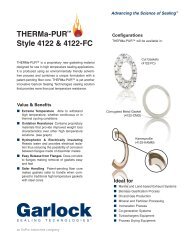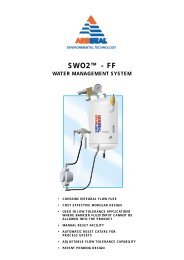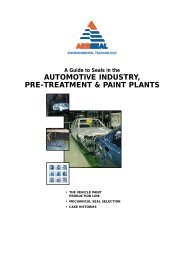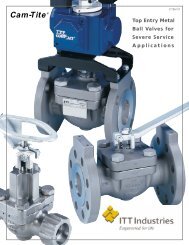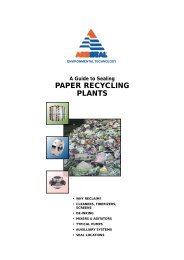expansion joints - AR Thomson Group
expansion joints - AR Thomson Group
expansion joints - AR Thomson Group
Create successful ePaper yourself
Turn your PDF publications into a flip-book with our unique Google optimized e-Paper software.
INSTALLATION PROCEDURES<br />
Removal of Old Expansion Joints<br />
1. Measurements - Prior to removing old <strong>expansion</strong><br />
<strong>joints</strong>, accurate measurements of the system should<br />
be taken. Measure the face-to-face dimension of<br />
the <strong>expansion</strong> joint and check the flanges for any<br />
misalignment such as lateral, torsional and/or angular.<br />
Refer to pages 8 thru 10 for measuring and<br />
evaluating misalignment.<br />
2. Pipe Anchors/Supports - Carefully inspect pipe<br />
anchors and flange supports before removing old<br />
<strong>expansion</strong> <strong>joints</strong>. Over the years pipe supports and<br />
anchors may become loose and the <strong>expansion</strong> joint<br />
may actually be supporting the pipe.<br />
3. Breaking Seal - With elastomeric <strong>joints</strong> it is important<br />
to break the seal of both flanges before the<br />
joint is removed. Forced removal with an unbroken<br />
seal may result in damage to the metal flange. To<br />
break the seal, drive small wooden wedges between<br />
the rubber flange of the joint and mating<br />
metal flange.<br />
Joint Handling and Transporting<br />
1. Expansion Joint Storage - An elastomeric <strong>expansion</strong><br />
joint should be stored in a cool, dry and dark<br />
place. Expansion <strong>joints</strong> can be stacked only when<br />
individually packaged in boxes or crates of sufficient<br />
strength. Expansion <strong>joints</strong> should always be posi<br />
tioned so that they are not resting or standing<br />
upright on their flange edges.<br />
2. Transportation of Large I.D. Joints - Care must<br />
be taken when transporting large <strong>expansion</strong> <strong>joints</strong><br />
from a storage area to the job site. Expansion <strong>joints</strong><br />
should never be rolled on their flanges or pulled<br />
with a cloth sling looped through the I.D. Large<br />
<strong>expansion</strong> <strong>joints</strong> should always be transported crated<br />
or on a platform laying in a horizontal position to<br />
prevent any possible damage. Once at the job site,<br />
the <strong>joints</strong> should always be laid flat on the floor and<br />
protected against damage.<br />
Preparation for Installation<br />
1. Area Accessibility - Installation of large I.D. <strong>expansion</strong><br />
<strong>joints</strong> requires a lot of manpower and an open,<br />
accessible area. Machinery or equipment which<br />
could complicate the installation must be removed.<br />
Sharp objects or rough surfaces which may damage<br />
the sealing surface of rubber flanges should be<br />
taped or removed ahead of time.<br />
2. Bolts/Fasteners - Used bolts and fasteners should<br />
be sand-blasted and inspected for damage.<br />
Corroded or damaged bolts should be replaced.<br />
Garlock also recommends the use of flat steel<br />
washers where joining retaining ring segments.<br />
3. Retaining Rings - Used split retaining rings must<br />
be checked for rust and warping. Rusted or corrod<br />
ed retaining rings should be corrected. Warped<br />
retaining rings should be replaced, since flatness of<br />
rings is critical for achieving and maintaining a seal.<br />
4. Mating Metal Flanges - Elastomeric <strong>expansion</strong><br />
<strong>joints</strong> must be mated against clean, smooth metal<br />
flanges. The mating metal flanges should be carefully<br />
examined for reasonable smoothness. Gouged or<br />
pitted flanges should be resurfaced or repaired. A<br />
suitable repair compound is Belzona “Super Metal”<br />
cement.<br />
5. Joint/Bolt Lubricants - The recommended lubricant<br />
for use with Garlock <strong>expansion</strong> ioints is a solution<br />
of graphite in water or glycerine. Another<br />
suitable <strong>expansion</strong> joint lubricant is Dow Corning<br />
DC-111, a silicone-based material. Any other joint<br />
lubricants must be approved by Garlock to insure<br />
chemical compatibility.<br />
Joint Installation<br />
1. Horizontal/Vertical Installation - Expansion <strong>joints</strong><br />
installed where metal flanges are in a horizontal<br />
position are first brought to the level of the flanges,<br />
then slid into place. Flanges may be lubricated to<br />
aid in sliding the <strong>expansion</strong> <strong>joints</strong> into place.<br />
Large <strong>expansion</strong> <strong>joints</strong> to be installed where<br />
metal flanges are in a vertical position will require<br />
hoisting into place. Hoisting of the joint can be<br />
accomplished with cloth slings. The joint must be<br />
looped on the outside with a separate loop formed<br />
on each side of the arch to prevent <strong>expansion</strong> joint<br />
damage.<br />
11



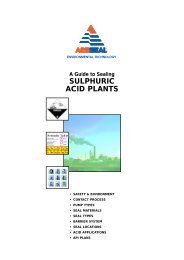
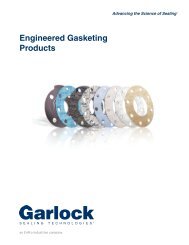
![VCS Flange Gasket [1.03 MB] - AR Thomson Group](https://img.yumpu.com/12044617/1/190x245/vcs-flange-gasket-103-mb-ar-thomson-group.jpg?quality=85)

![PGE Flange Gasket Product Brochure [1.04 MB] - AR Thomson Group](https://img.yumpu.com/12044595/1/190x245/pge-flange-gasket-product-brochure-104-mb-ar-thomson-group.jpg?quality=85)
